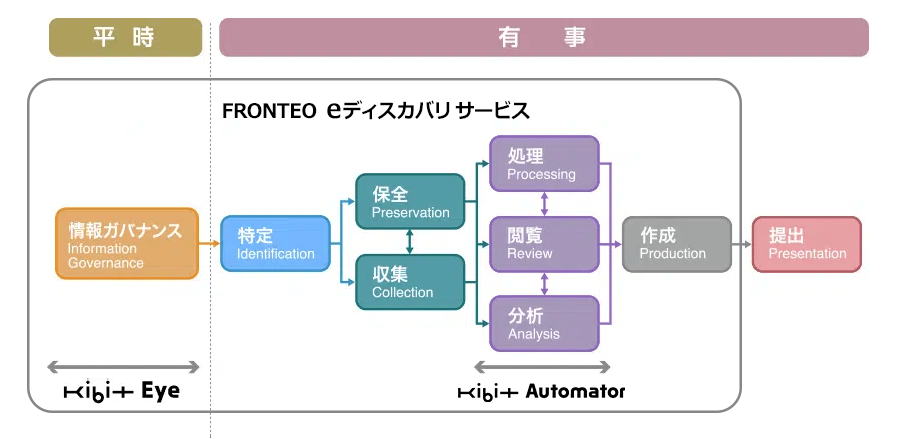Just because you are a Japanese company doing business in Japan does not mean that you are immune from U.S. litigation. When a company's legal staff is sued in the U.S., the process of "discovery" becomes important. The workflow for conducting "eDiscovery" for electronic data is called "EDRM (Electronic Disclosure Reference Model). This article explains what the EDRM workflow is, including an explanation of eDiscovery.

What is "EDRM"?
First, a brief explanation of U.S. litigation is in order. In U.S. litigation, the parties are required to have a meeting for discussion prior to trial. In today's IT-enabled society, e-discovery has become an increasingly important part of the litigation process.
 [Related Article] What is eDiscovery (eDiscovery)? Explanation of the need for countermeasures, risks, etc. For more information on "eDiscovery," please see this article. /fllp/ediscovery-basic
[Related Article] What is eDiscovery (eDiscovery)? Explanation of the need for countermeasures, risks, etc. For more information on "eDiscovery," please see this article. /fllp/ediscovery-basic Most litigation in the U.S. is concluded before trial through discovery. In most cases, e-discovery is a critical step in the litigation process. The workflow for conducting e-discovery is the "EDRM," which stands for "Electronic Discovery Reference Model," a globally standardized workflow.
Electronic data for e-discovery includes not only e-mails, but also any data obtained from databases, internal applications, website content, and any other electronic information. The scope of data to be submitted and its format will be determined and agreed upon between the parties (or their attorneys).
It takes time and money to search through the vast amount of data to find the data to be disclosed, and if data is accidentally erased or forgotten to be disclosed, it may be suspected of concealment. The EDRM, which has a history of being developed to streamline the handling of electronic data in discovery, is like a common language for judicial officials around the world, and following this workflow will be a fast track to resolving litigation.
EDRM Process and Workflow
The EDRM is a workflow consisting of six phases, nine items in total.

Information Governance
The first phase is "Information Governance," or the proper control of electronic information. Some companies do not centrally archive emails, documents, and content, but rather manage them on an individual and personal basis.
It is advisable to clarify how data is currently handled, establish policies on how to classify it, and manage it properly. Proper day-to-day data management is the first step to effectively and reliably achieve corporate compliance as well as e-discovery measures in U.S. litigation.
Identification
The next phase is to "identify" the location of the data subject to e-discovery. While the data to be disclosed will vary from case to case, the volume of potentially subject data is typically vast, and it is necessary to begin by determining the scope of the information to be disclosed in that case and what is stored where. The scope of data that may be relevant to the litigation should be established as early as possible with the General Counsel, assigned attorneys, litigants, and IT managers in order to quickly begin the "preservation" phase, which is the critical flow that follows.
Preservation
The third phase has two components, the first of which is preservation. From the time it is determined that litigation will occur, or is foreseeable, the relevant data must be preserved. The data identified will be protected from improper alteration, destruction, or deletion.
In fact, a Japanese pharmaceutical company was accused of destroying evidence in a U.S. lawsuit because it had destroyed information requested in e-discovery, and ended up being sued for a huge sum of approximately 620 billion yen in damages. In order to avoid such an irreversible situation, prompt preservation of relevant data, identification as a preliminary step, and information governance from ordinary times are indispensable.
Collection
In the case of electronic data, "collection" usually means "preservation" at the same time. Since there may be data and contents stored not only on the company's file servers, but also on staff PCs and smartphones, the preservation and collection of such information should be completed early and extensively.
Processing
Processing reduces the overall volume of data from the vast amount of data preserved and collected in the previous phases by sorting out the data that may be needed. Specifically, for example, program files that have no obvious relevance to the lawsuit are excluded, and duplicate files on the mail server are deleted. This is one of the most important steps in the e-discovery process, as the know-how used in this phase determines the outcome and cost of the entire discovery process.
Analysis
Analysis" is the process of identifying and extracting target data by conducting advanced keyword searches based on litigation-related keywords. If the data is in Japanese, the cost of discovery can be significantly reduced by extracting the appropriate data using a highly accurate search technology that can handle Japanese character codes. The data obtained from this analysis process is then moved to the next process, "browsing," which is performed by human operators.
Review
Review" is the process of sorting the data that has been sorted in "Processing" and extracted in "Analysis" into the data that should be disclosed and the data that should not be disclosed. Here, experts visually sort the data and identify the data that will ultimately be submitted as evidence by the attorneys. The number of people involved and the time required to complete this task should be estimated, and in many cases it will account for the majority of the cost of e-discovery. If translation support into English is required, it will be handled during this phase.
Production
The fifth phase is "production. The data that has been determined for disclosure is converted and processed into an appropriate format according to the specifications.
Presentation
The final phase is "presentation (submission). The company submits supporting materials to convince the public of its position and claims at public hearings and trials.
 [Related Article] See also this page for more information on "EDRM" e-discovery support. h ttps:// legal.fronteo.com/ediscovery/
[Related Article] See also this page for more information on "EDRM" e-discovery support. h ttps:// legal.fronteo.com/ediscovery/ Difficulties in handling EDRM on your own
Of the EDRM workflow, it is technically possible for IT managers and information system personnel to conduct up to preservation and collection together with the attorney in charge, and some cases are actually handled in such a manner. However, the conditions and circumstances vary widely depending on the nature of the litigation, and in order to properly respond to litigation as early as possible, it is better to consult with a vendor that provides e-discovery support services from the initial process and request such services to reduce concerns later on.
It is recommended to request vendors with expertise, technology, and know-how.
The scope of data to be disclosed is wide and the amount of data to be disclosed is huge, including not only emails but also messages, online documents, and contents, etc. EDRM is an important process not only to preserve and collect the target data, but also to screen whether the data should be disclosed. It is practical to request vendors with specialized knowledge and technical capabilities.
For inquiries about U.S. litigation and e-discovery, please contact us /contact/. How to choose an e-discovery support service company and what to look for
Learn how to find a reliable service vendor that can be entrusted with e-discovery measures.
Point 1: Knowledge and coverage of the e-discovery area
Check what kind of projects they have handled for what kind of companies, both in Japan and overseas. The number of cases they have handled will directly translate into know-how, which will lead to low-cost, high-quality support.
Point 2: Experience in e-discovery for Japanese companies
You may think that since e-discovery is a U.S. system, a vendor with experience in the U.S. would have an advantage, but in fact, a vendor with a thorough understanding of Japanese organizations, corporate practices, work styles, etc. will be able to facilitate the process.
Point 3: Ability to apply technology including AI (Artificial Intelligence)
In e-discovery, the most time-consuming and expensive part is the process of viewing data. By using software that identifies documents that may be relevant to the case, and by making use of AI and other technologies that enable fast and accurate searching and extraction, work that used to take hundreds of people weeks can be made overwhelmingly efficient and costs can be significantly reduced.
Point 4: Data Protection Measures
Since e-discovery often requires translation, if there is a flaw in the security system of the translation intermediary company outsourcing to individual translators, etc., there is a possible risk of information leakage. Check the data protection system. Also, to avoid data leakage out of the country, check whether the vendor is able to proceed with the workflow while keeping the data in Japan.
Point 5: Degree of customer service and support
There is a time difference between Japan and the United States. If a service vendor replies to your email 12 hours after you send it, or does not get through when you call, you can't expect a detailed response. Whether or not the vendor can provide global support and speedy service is also an important factor in determining whether or not the vendor is capable of providing global support.
For e-discovery support including EDRM, "FRONTEO" has a wealth of experience in international litigation using AI.
FRONTEO's e-discovery support services provide one-stop support for the entire EDRM process, which is a global standard workflow. As a pioneer of e-discovery support companies in Asia, FRONTEO has the technology and know-how cultivated over nearly 20 years of handling cases, and provides solutions that enable the departments in charge at client companies to efficiently collect, extract, and view electronic evidence and communicate with attorneys.
Providing efficient solutions utilizing AI (Artificial Intelligence)
Solutions using KIBIT, an AI (Artificial Intelligence) engine developed in-house, efficiently cover "processing," "analysis," and "viewing," which are the key elements of information governance and EDRM in normal times. KIBIT is particularly effective in "viewing," which is said to account for the majority of e-discovery costs. Our proprietary algorithms enable significant efficiency and cost reductions.
FRONTEO's AI engine flexibly handles a variety of systems and special data. It is capable of identifying difficult delimitation positions of multibyte characters represented by Japanese, Korean, Chinese, etc., which are difficult to handle with overseas tools, as well as handling special character codes unique to Japan and the simultaneous use of multiple mailers. We also have data centers in Japan and Korea to ensure full security measures.
For inquiries about U.S. litigation and e-discovery, please contact us at /contact/  [Related Article] FRONTEO's e-discovery consulting services To learn more about FRONTEO's e-discovery consulting services, please click here. /ediscovery/consulting/
[Related Article] FRONTEO's e-discovery consulting services To learn more about FRONTEO's e-discovery consulting services, please click here. /ediscovery/consulting/
